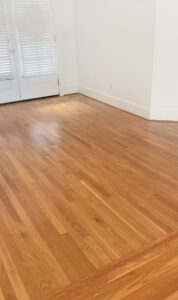If you have a hardwood floor that’s worn or stained, it may be time to consider refinishing. This process involves sanding the existing finish down and applying a new protective coating over the top.

Refinishing your hardwood floors is a time-consuming and expensive task that requires skill and experience. If you’re not confident in your skills, you should call a professional to handle the refinishing process for you.
When you refinish your wood floors, the first step is to prepare them for sanding and staining. This includes making sure you have the right type of wood, sanding down any scratches or dings, and choosing the correct stain color.
Solid hardwood is the most popular choice for refinishing, but you can also use engineered wood and laminate. However, these are much more difficult to refinish than real wood. They have thin veneers bonded to a layer of plywood, and it’s difficult to sand down the veneer without exposing the plywood underneath. So, you should only consider refinishing these floors once or twice.
During the refinishing process, you will need to make sure that you are using quality products. This includes the stain, varnish, and brushes that you will be using. These should be oil-based, low VOC (volatile organic compound), and have a tinting base that allows you to adjust the intensity of the color.
A reputable contractor should be able to help you choose the right stains and varnishes for your floors. These can be made of water-based or oil-based materials, but oil-based finishes are more durable and last longer than water-based ones.
It is important to note that some of these refinishing products can cause breathing problems, especially for those who have asthma or other respiratory conditions. This is why you should only hire a company that has a dust-free sanding and coating process.
Before the refinishing process begins, you should remove all furniture and heavy objects from your home. You should also move any rugs and pets to an area of the home where they will be safe from dust and chemicals.
The floor is the most exposed part of your home, so you should be especially careful when refinishing it. It is also a common practice for homeowners to apply furniture pads to the floor before refinishing, as this can help protect it from scratching.
Once the refinishing is complete, you should vacuum and wipe down your floor thoroughly to remove any lingering chemicals or dust. You should also keep all doors and windows open to let in as much fresh air as possible. This will also help reduce the odor from the polyurethane fumes that you can experience after refinishing.
Floors are a crucial part of the look of a home. They pull a room together and help establish its character, so it’s important that they are free of scratches, stains, or dents.
Fortunately, floor refinishing is a cost-effective way to get your floors back in shape. This process is especially beneficial for older floors that have seen better days.
Sanding is a key component of any refinishing project. It can bring old furniture and other wooden surfaces back to life, as well as make hardwood floors look like new.
It can also be used to remove scratches from painted walls or other surfaces. The process is simple and can be done by hand using sanding paper, or more often these days, with an electric sander.
The sanding process begins with the selection of a correct starting grit for your job. This grit should be coarse enough to quickly remove surface imperfections, such as deep scratches, but fine enough to leave behind a smooth surface that is ready for paint or staining.
As you sand, remember to follow the grain of the wood. The best sanding patterns are when you angle the sander across the grain to remove scratches and stains.
Once the sanding has been completed, the next step is to apply stain to the wood. This can be a wood stain, or it may be a clear coat of polyurethane. The finish will give the wood a new appearance and protect it from wear and tear.